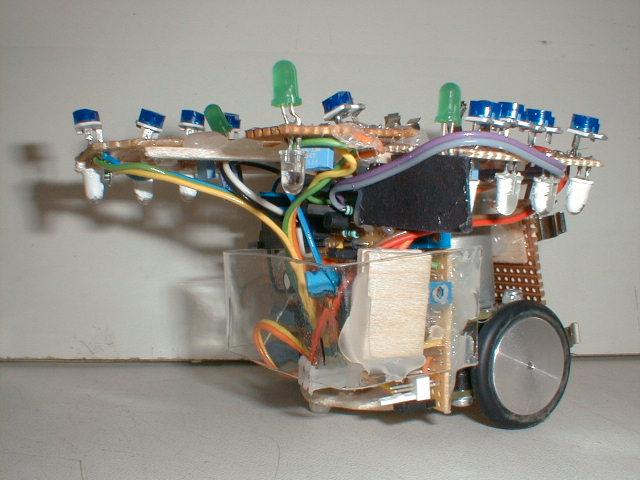|

DOT is a first attempt at a mouse for the new competition. It was built by the Swallow Systems' works team of Duncan and Creag Louttit and Stephen Eakins. It is only eligible for competitions open to adults so you need not worry about it for the July competition.
DOT uses our drive train and three Hamamatsu S4282-51 sensor chips. Two of the sensors use multiple LEDs so that they give area coverage. These are the one nearest the wall and the one to detect the presence of a wall in front of the mouse. The third sensor is spaced a short distance in from the wall sensor.
The motor drive circuitry is very similar to DASH FREE 99 but with a small modification to enable the motor voltage to get nearer to the battery voltage. In addition the right hand motor has a relay so that it can be reversed.
The signals going into the motor drives come from an array of trimmers via steering diodes. There are 5 trimmers for the right hand motor and three for the left hand motor. Not all of these possibilities are used.
There is an Atmel AVR 2313 processor. This is used to select which trimmer will be active corresponding to the sensor input signals. The algorithm is basically:-
Front sensor on:- turn right hard
Left sensor off:- turn left hard
Left and middle sensors on:- turn right gently
Left sensor on and middle sensor off:- turn left gently
Of course there are 8 combinations altogether so the best fit from these is used for the other combinations.
The processor selects the appropriate trimmer by making that output low and all the other trimmer outputs for that side high.
There is a separate output to control the brake. There is only a brake for the left hand motor as reversing the motor makes an even better brake for the right hand side. The brake is just a P-type MOSFET across the motor. The brake is on when the processor output driving the gate is low and off when it is high. The software ensures that the brake is not on when the motor has power applied.
There is a separate output for the reversing relay. A small-signal transistor provides the buffering between the processor and the relay. Don't forget a catching diode across the relay coil!
The power supply is 5 AAA NiCds. There is a diode/capacitor decoupling circuit between the processor and the batteries to remove spikes etc. from the motor driver. We cannot increase the voltage any further without over-running the processor's voltage specification.
DOT runs quite quickly. We cannot give times as it depends on the maze that it is put in. The limitation on how fast we can run the motors is the braking distance. To make significant improvements we would need to fit a better braking system, reduce the weight, or fit grippier tyres.
 HOME PAGE
HOME PAGE PIXIE
PIXIE DASH FREE
DASH FREE